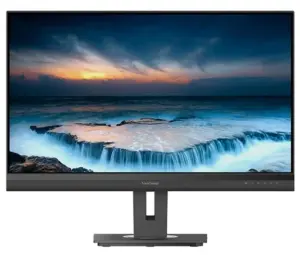There was news last week of a new 8K monitor, the VG3281, from ViewSonic that is being sold for the moment just in China. It got me thinking about the development of monitors.
First, the new ViewSonic monitor is based on an IPS panel with relatively modest performance of 300 cd/m2 of luminance and 1,000:1 contrast – it’s clearly aimed at desktop productivity use rather than HDR mastering. On the other hand, it is factory-calibrated with a specified DeltaE of ≤1, and it also covers 99% Adobe RGB and 99% DCI-P3 color gamut, so it should accurately represent color and would fit well into ViewSonic’s sustained work to develop its brand’s position in digital photography. There are dual HDMI2.1 ports and support for DisplayPort 1.4 as well as 96W of PD charging available.

There have been rumours about this monitor for quite a while, but there’s still no clear news of availability outside China, where it is reported to be for sale at around $2,400. The Dell 8K monitor currently lists at $4,025 and is the only other current 8K desktop monitor that I’m aware of.
8K on a 31.5″ diagonal gives 280ppi which is quite a high dot density. When Dell launched the first 8K monitor in this size, it did suffer a bit from small text in Windows, but over time, the support for higher resolutions has got better. On the other hand, a lot of digital photographers like Mac-based systems and Apple has a 5K 27″ and a 6K 32″ that both have 218ppi (and are brighter, with the Pro Display a lot brighter).
PPI
Apple built the early Macintosh around the idea that there were 72ppi on the display, so 72 pixels was exactly one inch. That, conveniently, matched the 72 points in an inch used by printers for measurement, and also happened to match the typical 1/72″ spacing of the pins on dot-matrix printers of the time (at least the ones from Epson). All of those numbers tying in meant that if you saw an object in 1:1 zoom on the monitor, it would be real-sized – as it would be when it was printed out. All of those numbers were developed 40 years ago and things have come on since then. The phrase ‘What You See is What You Get’ or WYSIWYG was the summary of this strategy of mapping the display to the printer.
Technologies such as Postscript liberated printing from the fixed dot system, and display and operating and graphics system developers also worked out how to scale different resolutions so that these days there are nothing like the issues of matching the display to other output devices. However, I can’t help but note that the current displays from Apple are almost exactly three times more dense than the 72ppi (if they were 216ppi rather than 218ppi, it would be exact). It’s certainly near enough that relatively simple display scaling keeps everything to still make a WYSIWYG display easy.
When I made the switch to Mac OS earlier this year, one of my concerns was that my venerable, but much loved, UltraHD 32″ monitor would not work well on the Mac with its 140ppi. In fact, as this is close to 2X the 72ppi, the monitor works absolutely fine. Apple didn’t support 8K output in some of its earlier systems, but these days it does via HDMI on the 14″ and 16″ MacBook Pro models and the M2 Pro Mac Mini. The Mac Studio also supports 8K along with multiple lower resolution displays.
Windows, of course, has been much more flexible in terms of the range of supported displays and resolutions and so has been through multiple generations of scaling and interface configuration options. Things aren’t as bad as they once were some apps were completely unusable on the wrong resolution of display, but I still saw some apps where the software publisher had clearly not tested the app on high resolution (high ppi) displays.
Personally, if I had one of these 8K monitors, I’d be severely tempted to upgrade my Mac Mini to the M2 Pro version to be able to get the best out of it. Then again, as I have previously admitted, I am a confirmed Pixelaholic!
Bob Raikes is semi-retired from the display industry, but still edits the 8K Association newsletter and contributes to Display Daily. He reported from Display Week for Display Daily, the 8K Association and Information Display.

